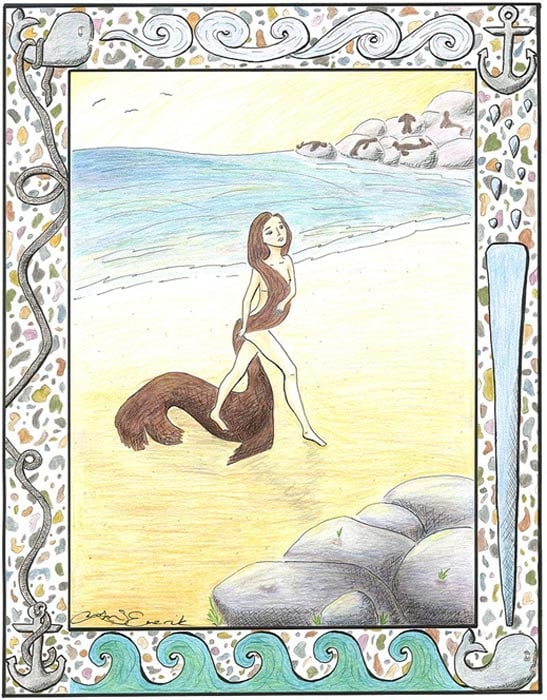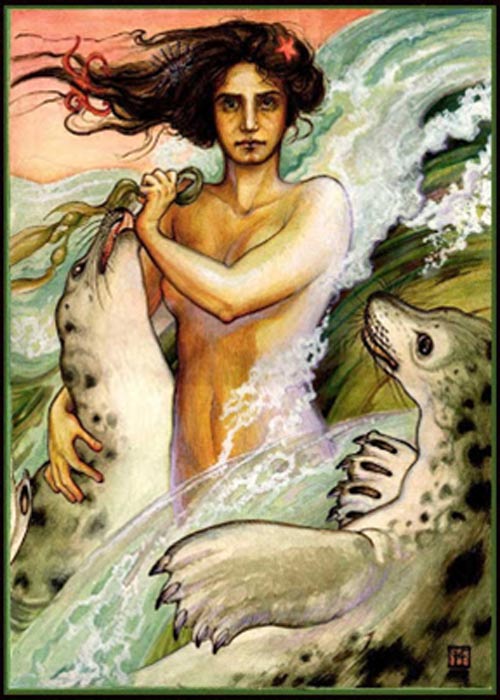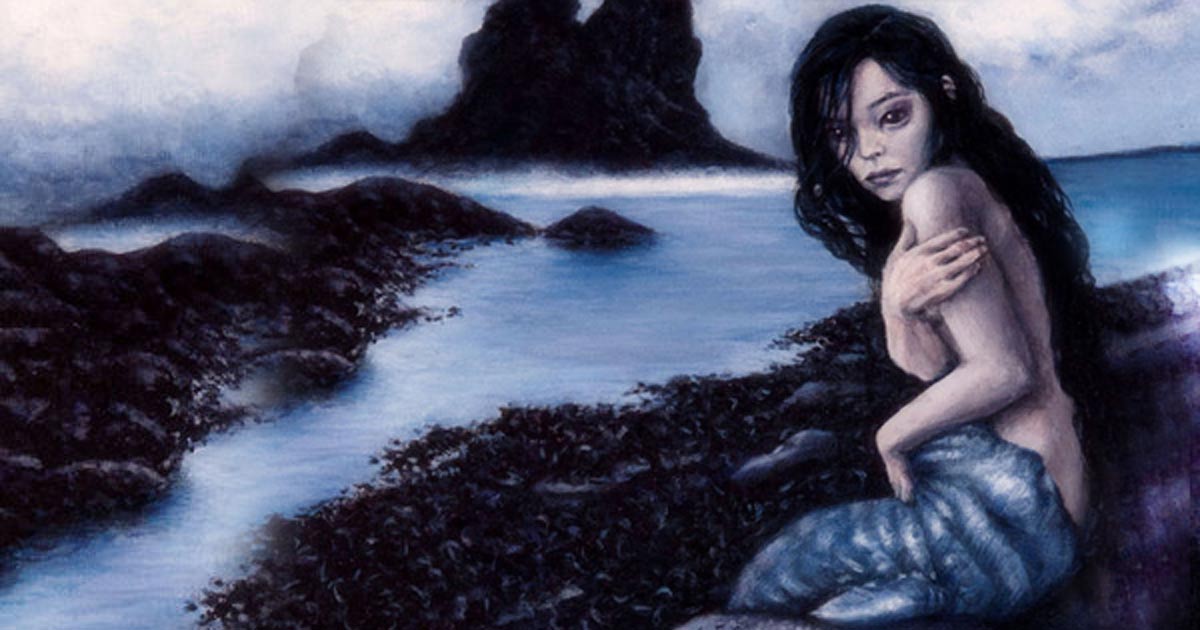Legends of the Selkies, Hidden Gems of Sea Mythology
Amorous, affectionate and affable, Selkies are the hidden gems of sea mythology. Gentle souls who prefer dancing in the moonlight over luring sailors to their death, Selkies are often overlooked by mythological enthusiasts for the more enthralling forms of mermaids or sirens. Yet Selkies play a prominent role in the mythology of Scandinavia, Scotland and Ireland. Their myths are romantic tragedies, a common theme for land/sea romances, however it is the Selkies who suffer rather than their human lovers and spouses. While the tales of Selkies always begin with a warm and peaceful "once upon a time", there are no true happy ending for the tales of Selkies—someone always gets his/her heart broken.
The mythology of selkies is similar to that of the Japanese swan maidens, though historically it appears that the tales of the swan maidens predate the western tradition. Selkies can be either men or women, but are seals while in the water. What differentiates them from mermaids (aside from the choice of animal) is that they undergo a full body transformation upon coming to shore: they do not merely transform seal tails into human legs, but rather completely shapeshift from the sea animals into a human. This is accomplished by shedding their seal-skin when they come to land. Selkies are predominately mythological creatures from Irish, Scottish (particularly in Orkney and the Shetland Islands) and Faroese folklore, however there is a similar tradition in Iceland as well.
- When the Church Bells Ring: Themes and Proclivities of the Danish Folktale "Agnete and the Merman"
- Oshun, African Goddess of Love and Sweet Waters
- The Evolution of Sea Monsters on Medieval Maps
Their name descends from the Scottish selich, and there does not appear to be a Gaelic term for these creatures. This is likely indicative of their prominence in early modern Scottish culture. It is believed that the Selkies arose in legends when early Scottish settlers and shipwrecked Spaniards married dark-haired, fur-wearing Finnish and Saami native women.

A seal-woman steps out from her seal coat on the beach. (CC BY-SA 3.0)
Described as incredibly handsome and beautiful, Selkies take the role of both predator and prey. Those who willingly come to land often seek those who are already dissatisfied in their daily lives such as the wives of fisherman. It appears more common in myths that the "predator" Selkies are usually the males, as tales indicate the men more often seek out lonely humans; however, there are also variations in which human women choose to summon male Selkies to the shore by sending seven tears to the sea. Selkies can only remain in the presence of humans for a short period of time, and then must commonly wait seven years to return the shore. That rule is broken, however, when a Selkie is forced to remain a human without his/her consent.

Male selkie (no-maam.blogspot.com)
The other way in which Selkies become part of human life is when their seal skin is stolen. These tales most often occur to female Selkies, creating the role of "prey" as mentioned above. It is not uncommon in myths for Selkies to come ashore and transform into humans for pleasure, and it is often during this time (when the skin is left unattended) that human men steal the female's skin.
- The Fiji Mermaid: What Was the Abominable Creature and Why Was It So Popular?
- Are tales of mythical mermaids inspired by a real-life medical condition?
- Ten Discoveries of 2014 that Suggest there is Truth to Ancient Myths and Legends
Once a Selkie is no longer in possession of his/her skin, the Selkie is under the hold of the human—most often depicted as a forced marriage. Interestingly, Selkie women are very good wives, but regardless of how happy a Selkie is on land, or how many children he/she beget during their time on the surface, once a Selkie recovers his/her lost skin, the Selkie immediately returns to the sea without looking back. Ironically, various tales also depict the half human children accidentally finding their parent's lost skin and returning it without being aware of the repercussions.

Illustration of a Slekie losing its skin. (sites.google.com)
One rather uncommon tale of Selkies reveals what happens if a Selkie chooses to return to the sea. It appears, according to one tale from the Faroe Islands, that upon making this choice, the Selkie is not able to return to his/her former life even if the Selkie wanted to. An abridged version of this tale describes a human husband sailing into a treacherous storm, saved only when his Selkie wife retrieves her skin and rescues him as a seal from certain death. Though this tale indicates a real love between the Selkie wife and her human husband, her donning of her seal skin will prevent her from ever taking part in the human world again. This is only one variation, of course, and thus is contradicted by other mythologies, however it is pertinent to the tale of Selkies because it reveals that all human/Selkie marriages are not hollow.

Painting of a female Selkie. (merbooksblog.blogspot.com)
Selkies are far tamer and much more gentile than their mermaid and siren counterparts, and it is likely this is because those cultures who believed in Selkies lived very close to the sea and, in a way, the edges of the world. To these cultures, the sea was both wild and bountiful at the same time. It is not unreasonable to assume that the nature of the Selkies has remained tame throughout their legends because the sea was a source of survival for the Scandinavians and Scotsmen who believed in them. While Selkies are less prominent in cultural traditions today, they should be valued for their preference to love rather than harm humans. It is more pleasant to image a Selkie mother watching over her human children from the sea, than a seductive mermaid planning her next underwater vanquish.
Top image: Selkies, gems of sea mythology by Gwillieth / DeviantArt
By Ryan Stone
Bibliography
Briggs, Katharine. 1976. An Encyclopedia of Fairies. Pantheon Books: New York.
Matthews, John and Caitlin. 2005. The Element Encyclopedia of Magical Creatures. Barnes & Noble Publishing.
Monaghan, Patricia. 2009. The Encyclopedia of Celtic Mythology and Folklore. Arrow Books: UK.
Spence, Lewis. 1948. The Minor Traditions of British Mythology. Rider and Company: Towrie, Sigurd. "The Selkie Folk." Orkneyjar: the heritage of the Orkney Islands. Accessed 1, August 2016. http://www.orkneyjar.com/folklore/selkiefolk/
Williamson, Duncan. 1992. Tales of the seal people: Scottish folk tales. Interlink Books: NY.


















Comments
There is a charming film on this subject –
The Secret of Roan Inish
1994 ‧ Drama/Fantasy ‧ 1h 43m
Any time a serious person see that myth, he quits reading. Few people could swim, especially in armor. There are no records of living Spaniards from Armada getting to shore (other than a couple of crippled ships). & if one had, the Irish would have killed them. WHY does this ignorant fantasy persist ? The pre-Kelts were small & dark. the "wild Geese" brought home Spanish wives,in laws & servants. Native Americans made it to Ireland many times. 3 valid origins of "darker" Irish. Oh & the later refugees from Inquisition (marranos & Huguenots).
You do understand that the women in these stories are being held hostage, right? Regardless of your views on modern women, the Selkie women had their lives stolen by the men who hid their seal skins. It's an unbalanced power relationship. I'd prefer modernism and the relationships that don't involve what boils down to kidnapping. But, that's just the opinion of a modern women.
Well David – it would depend on which Selkie myth you chose. Are you pining for one who is faithful until the end, or the usual type, who escapes to the sea with the first chance she gets? lol
An argument could be made for women in regards to the Nordic Fossgrim...a rather suave, but harmless male counterpart.
In any case, this article was treat to read!
Momo
Wouldn't it be wonderful if human women could be as gentle, feminine, and affectionate as these lovely Selkies? I would certainly trade a horrid, shrewish modern woman for one of these adorable creatures anytime! So would most other men...
Where would that leave horrid modern women? Who cares?